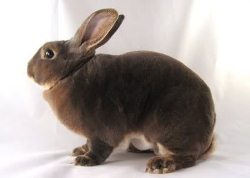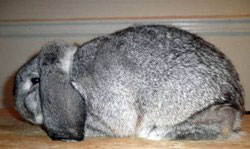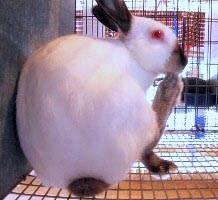Although there are five main color genes than determine the color of a rabbit’s fur, the c-series of genes is called the “color gene.” The color gene, which controls where and how much color will be expressed rather than which color will be expressed, is definitely one of the most difficult to understand. The first complication is that there are more variations of this gene than of most color genes. Another complication is that some genes are incompletely dominant over others. But in spite of its complications, genes at the C-locus is one of the most fascinating to work with.

Let’s start by thinking about which types of colors are produced when the different color genes are expressed. The dominant color gene is the “Full Color” gene represented by the capital “C.” Some full color rabbits are black, orange, chestnut, black tortoiseshell, lilac, and blue. The next gene, in order of dominance, is the chinchilla gene, which is represented by the letters chd (or sometimes Cchd or cchd). The letters stand for “chinchilla-dark.” You won’t be surprised to find that the chinchilla rabbit has the cchd gene. Other rabbits such as ermine, squirrel, chocolate chinchilla and lilac ermine also have the cchd gene as the dominant color gene. The next gene is the sable gene represented by cchl, which stands for “chinchilla-light.” Smoke pearl and sable point are examples of rabbits with the chl as the dominant color gene. Himalayans have the ch (or ch) gene while ruby-eyed whites (REWs) have two “c” genes.
What’s Going On Genetically – List of Genes at the C – Locus in Rabbits
Beginning with the most dominant and ending with the least, the color genes are “C,” which is the full color gene, “cchd,” which is the chinchilla gene, “cchl,” which is the sable gene, “ch,” which is the Himalayan gene, and “c,” which is the REW or albino gene.
The Full Color Gene — The full color gene is expressed anytime it is present. There are five combinations of genes that will cause a rabbit to be “full color.” A full color rabbit may be “C-C,” “C-cchd,” “C-cchl,” “C-ch,” or “C-c.” In full color rabbits, the color is not restricted to a certain part of the rabbit, but it spread over the entire rabbit. Other genes, such as the ee genes may cause a shaded look in a full color rabbit, but the color restriction is not due to the “C” gene in that case.

The Chinchilla Gene — The Chinchilla gene (cchd forchinchilla-dark) will be expressed if paired with any gene but the full color “C” gene. Chinchilla rabbits can be either “cchd-cchd,” “cchd-cchl,” “cchd-ch,” or “cchd-c.” When the chinchilla gene is expressed in rabbits, you generally find white or pearl fur where the full color rabbit has more yellow in the fur. The cchd gene causes the yellow pigment to be reduced. For example, an orange rabbit differs from an ermine (frosty or frost point) only in that the orange is a full color rabbit and the ermine expresses the chinchilla gene. Once the yellow pigment is eliminated from the orange, only the pearl remains.
It is worthwhile to note that the best chinchilla colors are produced with either a double cchd, a REW or Himalayan gene under the chinchilla gene rather than a sable gene. The sable gene tends to muddy the color, due to its incomplete dominance/recessive nature (more below on that).

The Sable Gene — With the sable gene (cchl), we find a slightly different situation than with other genes: incomplete dominance. With other genes, if you pair them with the same gene or one of lower dominance, that gene is expressed. With the sable gene, a pair of them together has a different result than the sable paired with a color gene of lower dominance (e.g., “ch” or “c”). Two sable genes produce a dark sepia color that is almost black, called “seal.” These seal-colored rabbits are “cchl-cchl.
The sable gene removes yellow from hair shafts and removes some of the darker pigments, giving a Holland Lop a shaded look (again, this shaded look is different from the shaded look caused by ee genes). Leaving seal rabbits to their own color family, sable rabbits are either “cchl-ch” or “cchl-c.”
This gene is sometimes called the “shaded” gene, though “sable” is a more correct term, because shadeds such as torts do NOT have the sable gene.
The Himalayan Gene — Himalayan rabbits have even more of the color restricted so that only the muzzle, ears and feet (the points) show the rabbit’s color. The rest of the fur is pure white. Thus, Himalayans are also called “pointed whites,” “Californians,” and “AOV” — depending on the breed. Himalayans come in just two geneotypes: “ch-ch” and “ch-c.”
The Ruby-Eyed White Gene — Ruby-eyed whites (REWs) are (surprise!) white rabbits with ruby eyes. There are 24 main varieties of REWs (not counting Es and Ej genes–or countless other modifiers) because two “cc” genes together negate whatever the other four genes are contributing to the rabbit’s coat color. All color is erased from the fur and eyes. Ruby-eyed whites are not genetically related to blue-eyed whites at all. The REW gene is the most recessive on the c-locus.
 |
 |

The C Series part II : Putting it all together.
